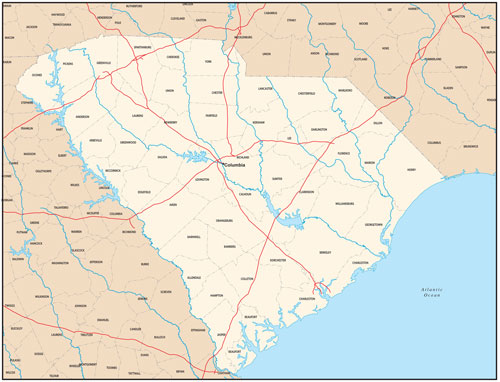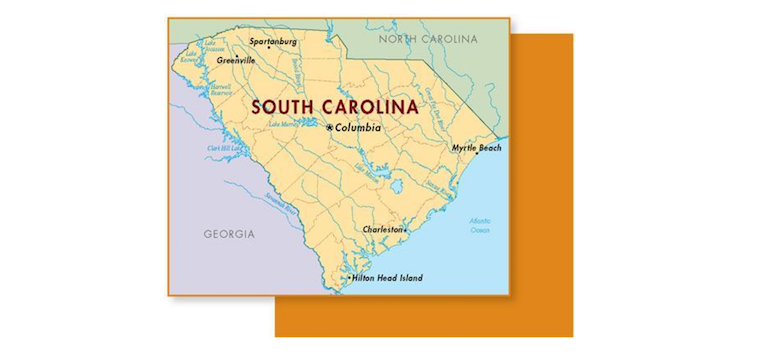Spain, France, and England all desired a permanent foothold along the Atlantic coast in the early 16th century. In 1663, Britain’s Charles II granted a charter to eight proprietors to colonize between 31 degrees and 36 degrees north latitude from sea to sea. English colonists built Charles Town near present-day Charleston in 1670. Early settlers — mostly from Virginia, British Caribbean and New England colonies, the British Isles, and France (Huguenots) — created an economy based on fur and deer-skin trade and production of foodstuffs and forest products. In 1712, North and South Carolina became separate provinces. Parliament to established both Carolinas as royal colonies in 1729.
South Carolina experienced remarkable growth in its first century. In the coastal lowcountry, plantations growing rice (after 1700) and indigo (from the 1740s) using slave labor began to dominate the economy. In the 1750s, settlement in the upcountry — the inland area and highlands in the northwest — began with yeomen farmers, some recruited from Europe and others moving overland from or through Pennsylvania, Virginia and North Carolina.
During the American Revolution, the British occupied Charleston from May 1780 to late 1782. More than 200 engagements took place in South Carolina, including conflicts between its numerous loyalists and its patriots.
By the 1820s, cotton culture dominated the state’s economy and slaves were the majority of the population. By 1860, the state had almost 704,000 residents; more than 57 percent were slaves. Free black and the foreign-born populations were each about 1.4 percent. Decades of economic and political tension came to a head after Lincoln’s election in 1860, when South Carolina seceded. The Civil War began in April 1861 as Confederate forces fired on Fort Sumter in Charleston Harbor. The city was under siege during much of the war. Sherman’s march to the sea in 1865 destroyed most of the capital, Columbia, and left the state impoverished. South Carolina was readmitted to the Union in June 1868.
Between the Civil War and World War II, agricultural domination declined, and the state’s economy diversified to include textile mills, food and forest products, fishing, and mineral industries. Poverty still gripped much of the state. By 1922, large numbers of African Americans had migrated to northern cities, leaving the black population a minority.
RESEARCH TIPS
- The state archives is South Carolina’s major research facility http://www.archives.sc.gov. Other important research locations are the South Caroliniana Library of the University of South Carolina in Columbia and the South Carolina Historical Society, Charleston.
- In the 18th century, parishes registered life events and provided aid to the poor. Many parish records have been published or placed at the South Carolina Historical Society.
- Before 1785, most legal documents were recorded in Charleston. Between 1785 and 1800 and since 1868, South Carolina’s civil divisions have been counties. Between 1800 and 1868, records were created in districts. Be sure to identify the ancestral parish, district, and/or county.
- The late establishment of the North-South Carolina boundary (1772) suggests that researchers consult records on both sides of the current line.
CENSUS RECORDS
- Federal census: 1790, 1800, 1810, 1830, 1840, 1850, 1860, 1870, 1880, 1900, 1910, 1920, 1930
- Federal slave schedules: 1850, 1860 (schedules name slaveholders but rarely name slaves)
- Federal mortality schedules: 1850, 1860, 1870, 1880
- Special census of Civil War Union veterans and widows: 1890
- State census: (all incomplete) 1829, 1839, 1869, 1875
GENERAL RESOURCES
- Books and Articles on South Carolina History by Leis P. Jones (University of South Carolina Press, 1991)
- Carolina Families: A Bibliography of Books About North and South Carolina Families by Donald M. Hehir (Heritage Books, 1994)
- A Checklist of South Carolina State Publications, 3 vols., by M. Hayes Mizell (Archives of South Carolina, 1962)
- A Collection of Upper South Carolina Genealogical and Family Records, 3 vols., edited by James E. Wooley (Southern Historical Press, 1979-82)
- Colonial Families of South Carolina compiled by Motte Alston Read (filmed by the Genealogical Society of Utah, 1952)
- Correct Mispronunciations of Some South Carolina Names by Claude Neuffer (University of South Carolina Press, 1983)
- Cyclopedia of Eminent and Representative Men of the Carolina of the Nineteenth Century (Brant & Fuller, 1892)
- Dictionary of South Carolina Biography, vol. 1., by Richard N. Cote and Patricia H. Williams (Southern Historical Press, 1985)
- The Growth and Distribution of Population in South Carolina by Julian J. Petty (Reprint Co., 1975)
- A Guide To Local Government Records in the South Carolina Archives by South Carolina Department of Archives and History (University of South Carolina Press, 1988)
- A Guide to the Manuscript Collection of the South Caroliniana Library by Allen H. Stokes (South Caroliniana Library, 1982)
- A Guide to South Carolina Genealogical Research and Records by Brent Howard Holcomb (Brent Howard Holcomb, 1998)
- Guide to the Study and Reading of South Carolina History, 2 vols., by James H. Easterby (Historical Commission of South Carolina, 1949-1950)
- History of South Carolina, 5 vols. by Yates Snowden and Harry G. Cutler (Lewis Publishing Co., 1920)
- Journal of the Commons House of Assemble, 1736-1754 (Historical Commission of South Carolina, 1951-)
- Lineage Charts South Carolina Genealogical Society Chapters, 4 vols., (Greenville Chapter, South Carolina Genealogical Society, ca. 1976-1987)
- Local and Family History in South Carolina: A Bibliography by Richard N. Cote (Southern Historical Press, 1981)
- Men of Mark in South Carolina, 4 vols., by James C. Hemphill (Men of Mark Publishing Co., 1907-1909)
- North Carolina-South Carolina Bible Records by Jeannette H. Austin (J.H. Austin, 1987)
- Records in the British Public Records Office Relating to South Carolina, 1663-1782 by Helen C. Carson (South Carolina Department of Archives and History, 1973)
- Research Materials in South Carolina by John Hammond Moore (University of South Carolina Press, 1967)
- A Sketch of the History of South Carolina to the Close of the Proprietary Government by the Revolution of 1719 by William James Rivers (McCarter & Co., 1856)
- The South Carolina Archives:, 2nd edition, by Marion C. Chandler (Department of Archives and History, 1976)
- South Carolina Genealogical Research by George K. Schweitzer (George K. Schweitzer, 1985)
- South Carolina Genealogies: Articles from the South Carolina Historical and Genealogical Magazine, 5 vols.
- (Reprint Co., 1983)
- South Carolina: A Guide for Genealogists by Theresa Hicks (Columbian Chapter, South Carolina Genealogical Society, 1996)
- South Carolina Newspapers by John Hammond Moore (University of South Carolina Press, 1988)
- South Carolina Research Outline by the Church of Jesus Christ of Latter-Day Saints (online at http://www.familysearch.org/eng/search/RG/guide/south_carolina.asp)
- South Carolina Women, 2nd ed. by Idella Bodie (Sandlapper Pub., 1991)
- The Story of the South Carolina Lowcountry, 3 vols., by Herbert Ravenel Sass (J.F. Hyer Pub., ca. 1956)
Return to the main South Carolina page
From the Family Tree Sourcebook
Also available: the State Research Guide Book, State Research Guides CD and The Researcher’s Guide to American Genealogy.


